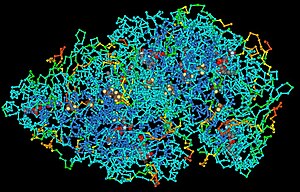A macromolecule is a very large molecule commonly created by polymerization of smaller subunits. In biochemistry, macromolecules are the three conventional biopolymers (nucleic acids, proteins, and carbohydrates), as well as non-polymeric molecules with large molecular mass such as lipids and macrocycles. The individual constituent molecules of polymeric macromolecules are called monomers (mono=single, meros=part).
Usage

The term macromolecule was coined by Nobel laureate Hermann Staudinger in the 1920s, although his first relevant publication on this field only mentions high molecular compounds (in excess of 1,000 atoms). At that time the phrase polymer, as introduced by Berzelius in 1833, had a different meaning from that of today: it simply was another form of isomerism for example with benzene and acetylene and had little to do with size.
Usage of the term to describe large molecules varies among the disciplines. For example, while biology refers to macromolecules as the four large molecules comprising living things, in chemistry, the term may refer to aggregates of two or more molecules held together by intermolecular forces rather than covalent bonds but which do not readily dissociate.
According to the standard IUPAC definition, the term macromolecule as used in polymer science refers only to a single molecule. For example,a single polymeric molecule is appropriately described as a "macromolecule" or "polymer molecule" rather than a "polymer", which suggests a substance composed of macromolecules.
Because of their size, macromolecules are not conveniently described in terms of stoichiometry alone. The structure of simple macromolecules, such as homopolymers, may be described in terms of the individual monomer subunit and total molecular mass. Complicated biomacromolecules, on the other hand, require multi-faceted structural description such as the hierarchy of structures used to describe proteins.
Properties

Macromolecules often have unusual physical properties. For example, individual pieces of DNA in a solution can be broken in two simply by sucking the solution through an ordinary straw. This is not true of smaller molecules. The 1964 edition of Linus Pauling's College Chemistry asserted that DNA in nature is never longer than about 5,000 base pairs. This error arose because biochemists were inadvertently and consistently breaking their samples into pieces. In fact, the DNA of chromosomes can be hundreds of millions of base pairs long.
Another common macromolecular property that does not characterize smaller molecules is their relative insolubility in water and similar solvents. Many require salts or particular ions to dissolve in water. Similarly, many proteins will denature if the solute concentration of their solution is too high or too low.
High concentrations of macromolecules in a solution can alter the rates and equilibrium constants of the reactions of other macromolecules, through an effect known as macromolecular crowding. This comes from macromolecules excluding other molecules from a large part of the volume of the solution, thereby increasing the effective concentrations of these molecules.
Examples

Some examples of macromolecules are synthetic polymers (plastics, synthetic fibers, and synthetic rubber), graphene, and carbon nanotubes.
Natural molecules are for example the bio-polymers such as DNA, carbohydrates, proteins and lipids, or polyphenols.
References
- Tanford, Charles (1961). Physical Chemistry of Macromolecules. New York, NY: John Wiley & Sons.Â
External links
- Synopsis of Chapter 5, Campbell & Reece, 2002
- Lecture notes on the structure and function of macromolecules
- Several (free) introductory macromolecule related internet-based courses
- Giant Molecules! by Ulysses Magee, ISSA Review Winter 2002â€"2003, ISSN 1540-9864. Cached HTML version of a missing PDF file. Retrieved March 10, 2010. The article is based on the book, Inventing Polymer Science: Staudinger, Carothers, and the Emergence of Macromolecular Chemistry by Yasu Furukawa.




0 komentar :
Posting Komentar